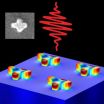(Press-News.org) WASHINGTON, DC, June 11, 2014 — Adolescents tend to be more powerful in influencing their friends to start smoking than in helping them to quit, according to sociologists.
In a study of adolescent friendship networks and smoking over time, the researchers found that friends exert influence on their peers to both start and quit smoking, but the influence to start is stronger.
"What we found is that social influence matters — it leads nonsmoking friends into smoking and nonsmoking friends can turn smoking friends into nonsmokers," said Steven Haas, an associate professor of sociology and demography at Pennsylvania State University. "However, the impact is asymmetrical — the tendency for adolescents to follow their friends into smoking is stronger."
Haas, who co-authored the study with David Schaefer, an associate professor in the School of Human Evolution and Social Change at Arizona State University, said there are a number of reasons why peer influence to start smoking is stronger than peer influence to quit.
"In order to become a smoker, kids need to know how to smoke, they need to know where to buy cigarettes and how to smoke without being caught, which are all things they can learn from their friends who smoke," said Haas. "But, friends are unlikely to be able to provide the type resources needed to help them quit smoking."
Nonsmoking friends do not have access to nicotine replacement products or organized cessation programs to help their friends quit, according to the researchers, who report their findings in the June issue of the Journal of Health and Social Behavior.
"Most often, adolescents will try to either quit cold turkey, or by gradually reducing their smoking and these are the least successful ways to quit," said Haas.
While most current adolescent smoking prevention programs are aimed at building resistance to peer pressure, Haas said school nurses and health professionals may be able to design programs that use peer pressure to positively influence behavior. For example, they could design programs to help nonsmoking adolescents help their smoking friends.
"We have to have a more nuanced view of influence," said Haas. "In reality, kids aren't all bad or all good and some friends who may not be a good influence in one area may actually be a positive influence in other areas."
The research may also apply to other aspects of adolescent behavior.
"This may apply well beyond smoking," said Haas. "There may be similar patterns in adolescent drinking, drug use, sex, and delinquency."
Even though smoking rates have declined, adolescent smoking remains a serious problem that has both health and economic costs. From 2000 to 2004, smoking and second-hand exposure to cigarettes were linked to 400,000 deaths, and smoking results in nearly $100 billion in lost productivity each year, according to the researchers.
The researchers used data from the National Longitudinal Study of Adolescent Health. Their sample data set included two high schools, with 757 and 1,673 student respondents, respectively. The data was collected at several times throughout the school year, giving researchers a chance to see not only how behaviors change, but also how networks of friendships evolve over time.
INFORMATION:
The Eunice Kennedy Shriver National Institute of Child Health and Human Development supported this research.
About the American Sociological Association and the Journal of Health and Social Behavior
The American Sociological Association, founded in 1905, is a non-profit membership association dedicated to serving sociologists in their work, advancing sociology as a science and profession, and promoting the contributions to and use of sociology by society. The Journal of Health and Social Behavior is a quarterly, peer-reviewed journal of the ASA.
The research article described above is available by request for members of the media. For a copy of the full study, contact Daniel Fowler, ASA's Media Relations and Public Affairs Officer, at (202) 527-7885 or pubinfo@asanet.org.
For more information about the study, members of the media can also contact Matt Swayne, Science and Research Information Officer, Penn State Research Communications, at (814) 865-5774 or mls29@psu.edu.
Peer influence leads teens to start, stop smoking -- but effect is stronger for starting
2014-06-11
ELSE PRESS RELEASES FROM THIS DATE:
Infant immune systems learn fast, but have short memories
2014-06-11
ITHACA, N.Y. – Forgetful immune systems leave infants particularly prone to infections, according to a new Cornell University study. Upending the common theory that weak immune cells are to blame, the study has found that infants' immune systems actually respond to infection with more speed and strength than adults, but the immunities they create fail to last.
Published in the Journal of Immunology, the discovery reveals a new angle immunizations could take in protecting infants and children from infectious diseases.
"The perfect vaccine would be a single dose given ...
Study confirms how the body regulates high levels of CO2 in the blood
2014-06-11
In a recently published study in the journal Experimental Physiology, Brazilian researchers have confirmed the importance of a specific group of neurons found in a region of the brain known as the retrotrapezoid nucleus (RTN) in detecting changes in carbon dioxide (CO2) levels and in modulating the activity of the neuronal groups that control respiratory activity.
Scientists from the Biomedical Sciences Institute of the University of São Paulo (USP) and the School of Dentistry at the São Paulo State University (Unesp) participated in the study.
"CO2 is important for regulating ...
Expert CLABSI guidance adds real world implementation strategies
2014-06-11
CHICAGO (June 1, 2014) – As central-line associated bloodstream infections (CLABSIs) pose a danger to vulnerable patients, infection prevention and control experts released new practical recommendations to assist acute care hospitals in implementing and prioritizing prevention efforts.
The guidance was published in the July issue of Infection Control and Hospital Epidemiology and produced in a collaborative effort led by the Society for Healthcare Epidemiology of America, the Infectious Diseases Society of America, the American Hospital Association, the Association for ...
Coordinated intervention reduced prevalence of drug-resistant CRE in long-term care
2014-06-11
CHICAGO (June 11, 2014) – A new study found a nationwide effort to control carbapenem-resistant Enterobacteriaceae (CRE) in Israel reduced CRE cases by improving compliance of infection control standards and using a coordinated intervention focused on long-term care facilities. The study was published in the July issue of Infection Control and Hospital Epidemiology, the journal of the Society for Healthcare Epidemiology of America.
"As the global threat of CRE continues to rise, there is a need to better control and understand this bacteria," said Debby Ben-David, MD, ...
EARTH Magazine: Dueling dinosaurs hit the auction block
2014-06-11
Alexandria, Va. — In 2006, a fossil collector and his crew discovered a rare fossil on private land in Montana's Hell Creek Formation: the bones of two fully articulated dinosaurs that appeared to have died together, locked in battle. The fossil duo — a small, pony-sized carnivorous tyrannosaurid and a slightly larger herbivorous ceratopsian, both now preserved in plaster — became known as the "Montana Dueling Dinosaurs." Last November, the fossils were put on the block at Bonhams auction house in New York City — but they did not sell. Had the set fetched the nearly $9 ...
Are Quebecers irrationally opposed to shale gas?
2014-06-11
Quebecers are particularly hostile toward the development of shale gas, but this aversion is driven less by 'not in my backyard' (NIMBY) attitudes than 'not in anyone's backyard (NIABY), according to a comparative study of 2,500 Quebecers and Americans conducted by Éric Montpetit and Erick Lachapelle of the University of Montreal's Department of Political Science. Professors Barry G. Rabe of the University of Michigan and Christopher P. Borick of Muhlenberg College co-led the study in the United States.
The study, commissioned by Quebec's Ministry of the Environment, ...
Findings may advance iron-rich, cadmium-free crops
2014-06-11
ITHACA, N.Y. – With news reports of toxic, cadmium-tainted rice in China, a new study describes a protein that transports metals in certain plants and holds promise for developing iron-rich but cadmium-free crops.
Iron and cadmium are both found in soil and are interchangeably taken up by iron transporters in plants. Pollution and heavy fertilizer use have increased soil cadmium levels in China, for example. In humans, cadmium can damage internal organs and cause cancer. At the same time, iron is an essential nutrient for plants and humans. Iron deficiency affects 30 ...
Manipulating and detecting ultrahigh frequency sound waves
2014-06-11
An advance has been achieved towards next generation ultrasonic imaging with potentially 1,000 times higher resolution than today's medical ultrasounds. Researchers with the U.S. Department of Energy (DOE)'s Lawrence Berkeley National Laboratory (Berkeley Lab) have demonstrated a technique for producing, detecting and controlling ultrahigh frequency sound waves at the nanometer scale.
Through a combination of subpicosecond laser pulses and unique nanostructures, a team led by Xiang Zhang, a faculty scientist with Berkeley Lab's Materials Sciences Division, produced acoustic ...
Famine fear won't sway minds on GM crops
2014-06-11
ITHACA, N.Y. – A sack-hauling time traveler from the 21st century lands in an Irish potato field in 1849, just before a terrible famine, and asks: If you thought genetically modified potatoes could avert late blight disease, spare a million countrymen from starvation and keep another million from emigrating off the Emerald Isle, would you plant these newfangled spuds?
Fast forward to the Internet Age, when communication researchers ran 859 U.S. grocery shoppers through a similar thought experiment: Half the subjects in an online survey read the story of the 1850s Irish ...
Benaroya Research Institute scientists identify drivers of rheumatoid arthritis
2014-06-11
(June 11, 2014 Seattle, Wash.)
Researchers at Benaroya Research Institute at Virginia Mason (BRI) used cutting-edge tetramer technology developed at BRI to find the T cells that drive rheumatoid arthritis (RA). "By using tetramer technology, we were able to examine whether T cells in people with rheumatoid arthritis were increased in number or were unique in other ways," says BRI Associate Director Jane Buckner, MD, who led the study with BRI Tetramer Core Laboratory Manager Eddie James, PhD. The findings were recently reported online in Arthritis & Rheumatology.
This ...

